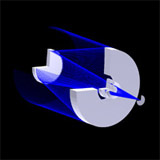Ceravolo 300 Astrograph Optical Design
Few pure reflecting telescopes have the well-corrected, flat field of view required to form sharp images to the corners of today's large CCD cameras. It is not uncommon for astro-imagers to crop the frame to eliminate flared or distorted stars at the edge of an image. CCD cameras are expensive, and if one is to utilize the potential of today's large CCD chips, a highly optimized imaging system is required.
The conventional, fast Newtonian reflector suffers from a tremendous amount of coma: the flaring of stars into comet-like shapes away from the field center. This aberration is so prominent that it can even be seen in images taken with small CCDs. Therefore, a field corrector is a must for a Newtonian. Even the venerable Ritchey-Chrétien (RC) variation of the Cassegrain reflector exhibits the effects of field curvature and astigmatism far off-axis. While the RC's aberrations are not large (a huge improvement from a basic Newtonian) an additional two lens field corrector eliminates the RC's slightly oblong star images at the corners of a large CCD chip.
 The Ceravolo 300 Astrograph features built-in field correctors, to produce razor-sharp star images to the corners of a large CCD. They are an integral part of the optical system, not an accessory. This approach allowed the design to be rebalanced by redistributing the workload among the mirrors and lenses, eliminating the usual aspheric secondary. The resultant Cassegrain mirror system resembles a Dall-Kirkham Cassegrain (elliptical primary and spherical secondary figures) with the addition of a triplet field corrector lens group positioned just behind the primary mirror.
The Ceravolo 300 Astrograph features built-in field correctors, to produce razor-sharp star images to the corners of a large CCD. They are an integral part of the optical system, not an accessory. This approach allowed the design to be rebalanced by redistributing the workload among the mirrors and lenses, eliminating the usual aspheric secondary. The resultant Cassegrain mirror system resembles a Dall-Kirkham Cassegrain (elliptical primary and spherical secondary figures) with the addition of a triplet field corrector lens group positioned just behind the primary mirror.
The field corrector in the baseline f/4.9 configuration has a near zero net optical power, and consequently no chromatic aberration is introduced by the lenses. No spectral dispersion is detectable from the near UV to the near IR, which is the typical spectral band covered by today's advanced CCD detectors. And as seen by the examples in the image gallery, even the f/9 configuration's field corrector is highly color corrected.
During the optical design process, the elimination of ghost images was just as important as achieving good image quality. The usual ghost images caused by internal reflections among the field corrector surfaces are not the only challenge; starlight also reflects off the mirror-like CCD detector back into the optical system. These spurious reflections can produce conventional ghost images and a very undesirable "pupil" ghost that must be avoided at all costs.
A unique feature of the Ceravolo Astrograph is the use of a very fast f/2 primary mirror to keep the overall telescope extremely compact - only 500mm, or 20" long. At 55% of the linear diameter of the primary aperture (30% by area), the secondary baffle obscuration is large by visual telescope standards, but quite typical of wide field imaging systems. This degree of obscuration is necessary in order to both fully illuminate the image plane and to shield it from extraneous light. To do otherwise would compromise the costly CCD chip's performance.
Designed to provide unparalleled versatility, the Ceravolo Astrograph delivers sharp images to the corners of a large CCD camera with two switchable configurations: the optically fast f/4.9 wide field mode, and the f/9 high resolution mode.